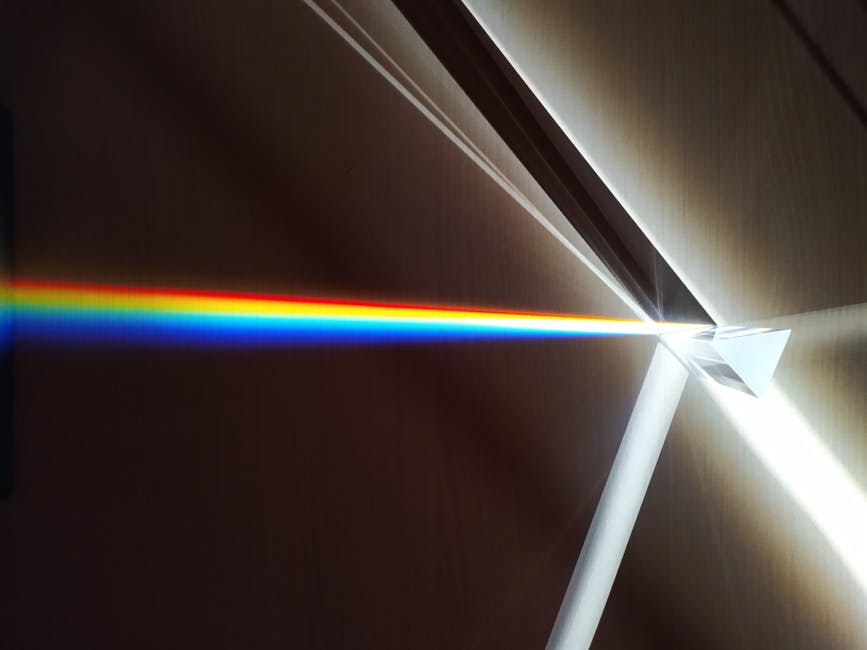Sunlight, streaming from the sun, is a complex mix of visible colors. When it interacts with Earth's atmosphere, this light undergoes various processes that influence our perception of the sky's color. Understanding these interactions reveals much about both natural phenomena and human vision.
Sunlight Composition and Interaction with Earth's Atmosphere
Sunlight comprises a mix of all visible colors, each traveling in waves with differing wavelengths. When viewed combined, this mixture appears white to the human eye.
As sunlight enters Earth's atmosphere, it encounters particles and gas molecules, initiating a scattering process. This scattering isn't uniform; it's selectively efficient depending on the light's wavelength. Shorter wavelengths like blue and violet light get scattered far more extensively than their longer-wavelength counterparts like red and yellow.
Rayleigh scattering, named after Lord Rayleigh, explains this phenomenon. According to this principle, shorter wavelengths are scattered almost ten times more than longer ones. Blue light, near the shorter end of the visible spectrum, meets a higher scattering probability. Therefore, the light you see when you look up at the sky during a sunny day is predominantly blue.
Despite violet light scattering even more, our eyes are less sensitive to it compared to blue. Additionally, the higher amount of blue light compared to violet emitted by the sun means our brains register a blue sky rather than a violet one.
At higher altitudes, such as in outer space or above Earth's atmosphere, the sky turns black due to the absence of atmosphere to scatter sunlight. Astronauts gaze into the deep blackness of space unless they look directly at the sun's intense glow.
Historical Sky Colors
Historically, our sky wasn't always blue. About 2.5 billion years ago, Earth's atmosphere was a toxic blend of gases, painting the sky orange. The emergence of cyanobacteria, performing photosynthesis, introduced oxygen, gradually transforming our sky to its current blue state over two billion years.1

Role of Rayleigh Scattering
Rayleigh scattering provides the fundamental explanation for why our sky appears blue. It involves the deflection of light by particles much smaller than the wavelength of the light itself. This scattering occurs more efficiently at shorter wavelengths, which makes it particularly impactful on the blue and violet ends of the visible spectrum.
The effectiveness of scattering is inversely proportional to the fourth power of the wavelength of light (λ). Mathematically, this relationship is expressed as:
I ∝ 1/λ4
Where I is the intensity of the scattered light.
As a result, shorter wavelengths—like blue and violet—experience much more substantial scattering compared to longer wavelengths, such as red and yellow. For example:
- Wavelength of blue light: ~400 nanometers (nm)
- Wavelength of red light: ~700 nm
- Blue light scatters approximately (700/400)4 = 9.4 times more than red light
Rayleigh scattering also explains the variations in color we observe at different times of the day. At sunrise and sunset, sunlight must traverse a thicker portion of the atmosphere, increasing the path length and scattering blue and violet light out of our direct line of sight. This extended atmospheric passage leaves the longer wavelengths, primarily reds and oranges, to dominate the celestial canvas during these transitional periods.
The fourth power law underlying Rayleigh scattering demonstrates a remarkable sensitivity to small differences in wavelength. Even a modest increase in wavelength results in a substantial decrease in scattering intensity. This characteristic is integral to why the bluer end of the spectrum is scattered so vividly, giving our daytime sky its iconic azure hue.
Human Eye Perception
The physiology of the human eye and the way our brain interprets color play crucial roles in determining the perceived color of the sky. Our eyes are equipped with photoreceptors called rods and cones:
- Rods: Highly sensitive in low-light conditions, primarily detect light and dark
- Cones: Responsible for color vision, come in three types:
- Long wavelength sensitive (red)
- Medium wavelength sensitive (green)
- Short wavelength sensitive (blue)
While violet light is scattered more efficiently than blue light due to Rayleigh scattering, the sky doesn't appear violet to us. This discrepancy arises because:
- Our eyes are less sensitive to violet light
- The cone cells in our retinas sensitive to shorter wavelengths are more responsive to blue rather than violet
- Sunlight reaching Earth contains a lesser proportion of violet light compared to blue and green light
- The lens of our eyes absorbs some of the violet light before it reaches the cones
The brain interprets the signals sent by the cones and creates the color experience we observe. Even though there is a significant amount of violet light being scattered by the atmosphere, the combination of the lower sensitivity of the blue cones to violet light and the greater responsiveness to blue wavelengths skews our perception, rendering the sky predominantly blue.
The sun's peak emission in the visible range is subtly biased to the blue part of the spectrum. So, even though our atmosphere scatters violet light more efficiently, the relative lack of violet light being emitted by the sun means there simply isn't enough violet light to overpower the blue light for our cones to detect.
The other cone cells that respond to green and red wavelengths also play a part in shaping our perception of the sky. The signals from these cones, blended with those from the blue-sensitive cones, result in a combined signal that the brain processes as "blue" rather than violet.
Variations in Sky Color
Variations in sky color, particularly during sunrises, sunsets, and lunar eclipses, are a direct consequence of the dynamics of light scattering and the atmosphere's composition.
Sunrise and Sunset
During sunrise and sunset, sunlight must pass through a greater thickness of Earth's atmosphere compared to when it's overhead. This increased path length enhances the scattering effect. Shorter wavelengths like blue and violet are scattered out of our direct line of vision more efficiently, leaving the longer wavelengths—reds and oranges—predominantly visible.
Influencing Factors
- Dust: Can enhance scattering, leading to vivid sunsets
- Water vapor: In humid conditions, can create more pastel-like tones
- Pollutants: Often deepen reds and oranges due to additional scattering and absorption
- Volcanic eruptions: Particles injected into the upper atmosphere can enhance scattering, creating a spectrum from deep purples to fiery reds
Lunar Eclipses
During lunar eclipses, the Earth's shadow covers the moon. Some sunlight still reaches the moon by refracting through Earth's atmosphere. This refracted light is predominantly red because the shorter wavelengths are scattered out, while the longer, red wavelengths make it through, casting a reddish shadow on the moon and giving it a coppery glow.
The interplay of various atmospheric elements and the wavelength-dependent scattering of light enriches our visual experience of the sky. Each sunrise, sunset, or lunar eclipse is a unique blend of these factors—a natural phenomenon painted by the subtle shifts in Earth's atmospheric conditions.

The blue sky we admire daily is a result of intricate interactions between sunlight and Earth's atmosphere, coupled with the unique sensitivities of human vision. This phenomenon highlights the connection between natural forces and our perception of the world around us.
- Lyons TW, Reinhard CT, Planavsky NJ. The rise of oxygen in Earth's early ocean and atmosphere. Nature. 2014;506(7488):307-315.
![]()
